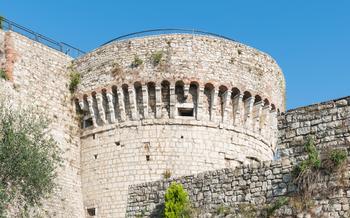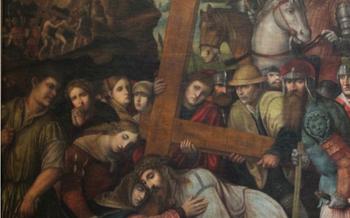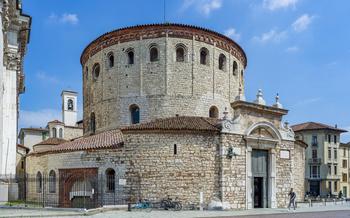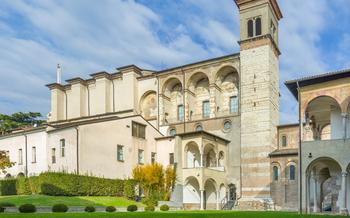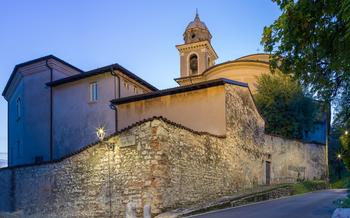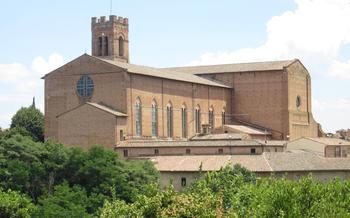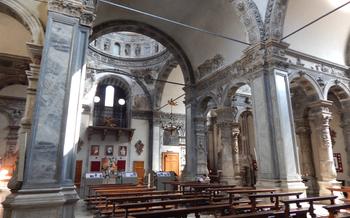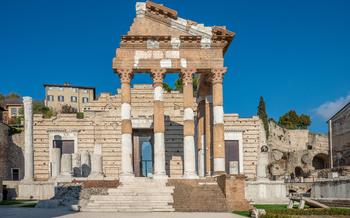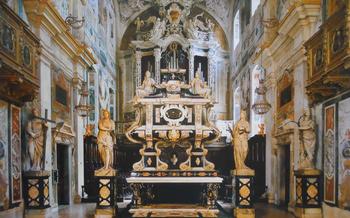
Chiesa di San Martino
- Chiesa di San Martino: A Sanctuary with Artistic Charm
- The History of Chiesa di San Martino
- Architecture and Design
- The Interior's Artistic Treasures
- Piazza Duomo and Surrounding Area
- Religious Traditions and Rituals
- Visitor Tips: Planning Your Visit
- Art Appreciation and Interpretation
- Other Notable Churches in Brescia
- Local Cuisine and Dining
- Suggested Itinerary for a Day in Brescia
- Brescia's Cultural Heritage
- Transportation and Accessibility
- Insider Tip: Hidden Gems to Discover
Chiesa di San Martino: A Sanctuary with Artistic Charm
Brescia, a city nestled in northern Italy's Lombardy region, boasts a wealth of historical and cultural treasures. Among them, the Chiesa di San Martino stands out as a testament to artistic brilliance and spiritual devotion. This awe-inspiring sanctuary is not just a religious edifice but a breathtaking work of art, beckoning visitors to delve into the depths of its history, architecture, and artistic prowess.
Its grand facade, adorned with intricate carvings and sculptural masterpieces, hints at the artistic wonders that await within. Step inside, and prepare to be captivated by the ethereal beauty of its interior. Every corner of the church whispers tales of faith, devotion, and the enduring power of artistic expression.
The History of Chiesa di San Martino
The Chiesa di San Martino has a rich and storied history that dates back to the early Christian era. It is believed that a small church or oratory dedicated to Saint Martin of Tours existed on the site as early as the 4th century AD. However, the current structure was built in the 12th century, following the destruction of the earlier church by fire. The church was designed and constructed in the Romanesque style, which was popular in Italy at the time. It initially served as the cathedral of Brescia but was replaced by the Duomo Nuovo in the 19th century. Despite this, the Chiesa di San Martino remains an important religious and cultural landmark in the city, attracting visitors from around the world. Throughout the centuries, the church underwent several renovations and modifications, reflecting the changing artistic and architectural styles of the time. Notably, the nave and aisles were rebuilt in the Renaissance style in the 16th century, adding to the church's unique blend of architectural elements.
Architecture and Design
The Exterior's Enduring Appeal
The Chiesa di San Martino's exterior facade is a captivating blend of Romanesque and Gothic architectural styles. Constructed primarily of local stone, it exudes a sense of solidity and permanence. The lower portion features a series of blind arches, adding depth and texture to the facade. The upper section, adorned with intricate carvings and delicate tracery, showcases the church's Gothic influence.
Unique Facade Elements
One of the most distinctive features of the facade is the central rose window. This stunning circular window, filled with colorful stained glass, depicts scenes from the life of Christ. The intricate detailing and vibrant hues create a mesmerizing effect, drawing the gaze of visitors from afar.
Symbolism in Architectural Details
Every element of the Chiesa di San Martino's architecture carries symbolic meaning. The three portals, for instance, represent the Holy Trinity - Father, Son, and Holy Spirit. The sculptures and carvings that adorn the facade depict biblical figures and saints, serving as a visual reminder of the church's dedication to Christianity.
The Interior's Artistic Treasures
The interior of the Chiesa di San Martino is a treasure trove of artistic masterpieces that leave visitors in awe. The walls and ceilings are adorned with breathtaking frescoes and paintings, each telling a story from the Bible or the lives of the saints. The most notable works include the stunning frescoes by Vincenzo Foppa, a renowned artist of the Renaissance period. His vibrant and lifelike depictions of biblical scenes, such as the "Adoration of the Magi" and the "Nativity," are a testament to his exceptional skill and artistry.
Other highlights of the interior include the altarpiece by Romanino, depicting the "Madonna and Child with Saints," and the intricate carvings by Sansovino, an acclaimed sculptor of the High Renaissance. The church also houses a collection of precious relics, including the remains of several saints and martyrs, which are displayed in elaborate reliquaries. The overall effect of the interior's artwork is one of profound beauty and spirituality, creating an atmosphere that is both awe-inspiring and uplifting.
Piazza Duomo and Surrounding Area
Chiesa di San Martino is situated in the heart of Brescia's historical center, in Piazza Duomo, a square that showcases the city's architectural heritage. The church stands in harmony with neighboring buildings, including the impressive Palazzo Broletto, the seat of the ancient city council. Visitors can admire the architectural continuity between these structures, creating a cohesive and visually appealing urban space. The surrounding area is further enriched by ancient Roman ruins, archaeological remains, and other landmarks that provide a glimpse into Brescia's rich past.
Religious Traditions and Rituals
Chiesa di San Martino stands as a central figure in Brescia's religious landscape. Throughout the year, the church hosts a multitude of special ceremonies, celebrations, and cultural events that showcase the deep spiritual significance it holds for the local community. During the Holy Week leading up to Easter, the church transforms into a hub of religious fervor, with solemn processions, reenactments of the Passion of Christ, and heartfelt prayers filling its sacred halls. Adding to its spiritual charm, the church also organizes regular masses, choir performances, and inspirational talks, inviting visitors to immerse themselves in the rich tapestry of Brescia's religious traditions and practices.
Visitor Tips: Planning Your Visit
To fully appreciate the beauty and significance of Chiesa di San Martino, plan your visit carefully. The ideal time to visit is during the morning or late afternoon when the light beautifully illuminates the interior. To ensure a serene and respectful atmosphere, dress modestly and appropriately.
Before your visit, explore the church's official website or consult travel guides to learn about upcoming events, exhibitions, or special tours. If you're interested in a more in-depth understanding, consider booking a guided tour or renting an audio guide to gain valuable insights into the sanctuary's history and artwork.
Art Appreciation and Interpretation
To fully grasp the beauty and significance of Chiesa di San Martino's interior, consider partaking in a guided tour or utilizing an audio guide. These resources provide in-depth knowledge and historical context, allowing you to understand the symbolism and hidden meanings behind the artwork. Learn about the techniques and influences of the renowned Renaissance artists who graced the sanctuary with their masterpieces.
Engage in self-guided exploration by delving into the historical context and background of the artwork. Research the symbolism and iconography depicted in the paintings and frescoes. This deeper understanding enhances your appreciation for the artistic treasures within the church, revealing layers of meaning and symbolism.
Other Notable Churches in Brescia
Brescia boasts a treasure trove of other remarkable churches that captivate visitors with their architectural splendor and artistic significance. San Faustino Maggiore, located in the heart of the city, is an architectural masterpiece that blends Romanesque and Gothic styles. Its stunning interior features intricate frescoes and paintings, including a remarkable depiction of the Crucifixion by renowned artist Moretto da Brescia.
Santa Maria dei Miracoli, also known as the "Church of Miracles," is another must-see for its exceptional Renaissance architecture. This small yet exquisite church is adorned with breathtaking frescoes by Giovanni Antonio Pandolfi, narrating the life of the Virgin Mary and the miracles attributed to her.
Local Cuisine and Dining
Brescia's culinary scene is as rich and varied as its history. Traditional Brescian dishes are a testament to the city's agricultural heritage, with an emphasis on fresh, seasonal ingredients. Must-try dishes include Casoncelli, delicate pasta parcels filled with meat and vegetables, often served with melted butter and sage. Polenta Taragna, a hearty cornmeal porridge with buckwheat flour and melted cheese, is another local favorite. For a taste of the lake, try Tinca al Forno, a baked tench fish dish with herbs and white wine.
For a memorable dining experience, venture into the narrow streets surrounding the church, where you'll find charming trattorias and cafes. Osteria del Gambero is a beloved institution, serving traditional Brescian cuisine in a cozy atmosphere. Ristorante Al Pescatore offers a delightful lakeside setting, specializing in fish dishes and local wines. For a quick bite, try Street Food del Carmine, a lively market with food stalls offering local specialties and international flavors.
Suggested Itinerary for a Day in Brescia
Begin your day with a visit to the enchanting Chiesa di San Martino, where you can immerse yourself in its artistic and spiritual magnificence. From there, stroll through the picturesque streets of the historical center, admiring the architectural wonders that line your path.
Make your way to the grand Piazza della Loggia, where you can marvel at the ornate Palazzo della Loggia, a testament to the city's rich history. Continue your exploration by visiting the Museo di Santa Giulia, a treasure trove of art and history housed within a former monastery.
Next, head to the vibrant Piazza del Duomo, where you can admire the grandeur of the Duomo Vecchio and the Broletto, symbols of Brescia's religious and civic heritage. Explore the narrow alleys and hidden piazzas, discovering charming cafes and boutiques along the way.
End your day with a leisurely walk along the scenic promenade of the Castello di Brescia, where you can soak in breathtaking panoramic views of the city and the surrounding landscapes. As the sun sets, immerse yourself in the magical atmosphere of Brescia, a city where history, art, and culture intertwine to create an unforgettable experience.
Brescia's Cultural Heritage
Brescia's rich cultural tapestry is a blend of diverse influences that have shaped its identity throughout history. A city with a strategic location, it has been a crossroads for different civilizations, each leaving its imprint.
The Celts, the Romans, the Longobards, and the Venetians have all contributed to Brescia's unique heritage.
This legacy is evident in the city's architecture, art, and culture. From imposing Roman ruins and medieval churches to Renaissance masterpieces and contemporary art galleries, Brescia offers a journey through time.
Must-visit museums include:
- Museo di Santa Giulia: a former monastery housing an extensive collection of Roman, medieval, and Renaissance artifacts
- Pinacoteca Tosio Martinengo: showcasing a rich array of paintings from the 13th century to the present
- Museo delle Armi: dedicated to the history of firearms and weaponry, with a vast collection of armor, swords, and guns.
Strolling through Brescia's historic center is like stepping back in time, with narrow cobbled streets and piazzas adorned with elegant palazzos and charming shops.
The city also boasts an active cultural scene with theaters, cinemas, and music venues hosting a variety of performances and events throughout the year.
Transportation and Accessibility
Getting to Chiesa di San Martino is a breeze with Brescia's efficient public transportation system. Hop on buses numbered 1, 2, 3, 10, 14, 16, or 17, all of which make stops near the church. For those arriving by car, there are several parking options nearby, including the Parcheggio Duomo and the Parcheggio Piazza Vittoria. Street parking is also available in the surrounding area.
For visitors with disabilities, the church is easily accessible. There are ramps and elevators that provide convenient access to all parts of the sanctuary. Once inside, wheelchair users can move around comfortably thanks to the spacious layout.
Remember, it's always a good idea to plan your transportation in advance. Check the schedules for public transportation, especially if you're traveling during peak hours. If you're driving, make sure to arrive early to secure a parking spot.
Now, let's move on to some insider tips for an unforgettable visit to Chiesa di San Martino!
Insider Tip: Hidden Gems to Discover
Beyond the main attractions, Chiesa di San Martino holds hidden gems waiting to be discovered by curious travelers. As you explore the church, keep an eye out for these secrets:
-
Secret Chapel: Tucked away in a secluded corner, find a hidden chapel adorned with intricate frescoes telling stories from the Bible.
-
Crypt: Descend into the depths of the church to discover a crypt containing ancient tombs and artifacts, offering a glimpse into Brescia's rich history.
-
Rooftop Views: Climb to the rooftop terrace for a breathtaking panoramic view of the city, with the Duomo and surrounding landmarks within sight.
-
Unique Perspectives: Explore different angles and vantage points within the church to capture unusual and artistic photographs of its architectural details and artwork.
-
Symbolism Unveiled: Delve into the symbolism and hidden meanings embedded in the paintings and sculptures, revealing the profound messages and narratives they convey.

